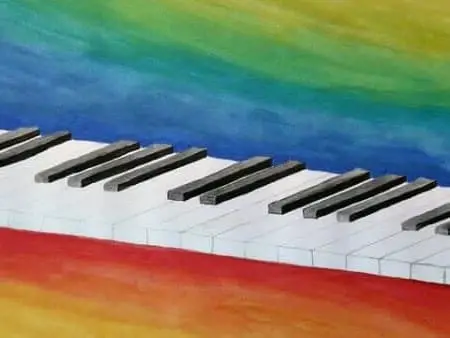- Home
- Piano Scales
- Common Music Scales
Common Music Scales: Colors of Sound
This article may contain compensated links. Please read the disclosure for more info.
Common music scales, and more uncommon, are what create the particular color of sound in a piece. A scale may create a mood, like happy or sad, oriental or bluesy, for example.
Common Music Scales
Musical scales, called “roads” in Greek traditional music or Ragas in Indian classical music, are like the soul of the music and give different styles of music their character.
In the musical traditions of the western hemisphere, the most common scales today are major and minor scales. But they are actually only two out of many, many other fantastic scales!
Of course, all scales and modes can not be played on all instruments. Because musical scales may contain microtones that might not be playable on a particular instrument like the piano, for example.
Let's take a look at how a scale is built, and a few of the most common scale types in the western music tradition.
 C major or Ionian scale, ascending and descending.
C major or Ionian scale, ascending and descending.How a scale is built
A scale consists of pitches organized in a certain pattern of distances between them. Each type of scale has its own specific pattern.
These distances between the pitches are called Intervals.
The two most used intervals that are used to "build" common music scales are the semitone (a half step) and the whole tone (whole-step).

The Half Step or Semitone
So, we first need to take a closer look at the semitone or half step, the smallest interval in the Western music tradition, to learn more about this little interval that is so important in a music scale.
Learn all about the Semitone here >>.
Whole Tone
The whole tone is the distance of two semitones.
Semitones and whole tones, (or half and whole steps) are the building blocks of the common music scales major and most minor, as well as the musical modes.
Read more about the Whole Tone here >>.
Common music scales
The c major scale
Normally the C major scale is the first scale we encounter.
Why? Well, for several reasons. If you learn the piano it is the easiest scale to see the pattern of, as you first learn to play, because it uses only white keys.
And, for other instruments, since it uses no altered notes, it is easier not to have to think about sharps or flats at first!
Read more about the C Major Scale >>
Major Scales
All the 12 major scales that we can play are actually only one! Or are there 15...?
Learn more about Major Scales here! >>
Minor scales
Now it is getting even more interesting!
A minor scale is actually only one scale but with several alterations. So one minor scale can sound in three ways- lovely!
The three types of minor scales are:
Pentatonic scales
The pentatonic scales are great scales for piano beginners. If you play the piano you can see the pattern of a pentatonic scale on the black keys.
 A pentatonic scale is hidden in plain sight playing the black keys!
A pentatonic scale is hidden in plain sight playing the black keys!This scale is common in traditional music all over the world.
Many famous songs are actually made from a pentatonic scale, like “Auld Lang Syne” for example. Try picking it out on the black keys! Easy!
Whole Tone Scale
As the name says, this is a scale made from only whole tones or whole steps. This creates a characteristic “open” sound, used by for example Claude Debussy in Voiles.
Learn more about the Whole Tone Scale here.>>
Chromatic scale
The Chromatic scale, from the Greek word chroma meaning color, is a scale made from only half steps or semitones.
You would probably not compose music using only a chromatic scale, but it is great to use as a bridge or to "color" a particular passage in a piece, like for example in Fur Elise by Beethoven.
Blues scale
The blues scale is one of the essentials in a blues.
Together with the particular chord sequence called a 12 bar blues pattern, and the three-part phrasing with a repeated A-part, it is the essential recipe for a beautiful, soulful blues…
Learn more about the Blues Scale here >>>
More about common music scales
Key signatures
Every scale in major and minor is represented at the start of each staff by a Key (or tonality) Signature.
Then you immediately know what notes you need to alter with sharps or flats already before you start playing the piece.
Read more about key signatures:
Music scale degree names
Have you heard about the Tonic, Subdominant and the Dominant?
Each step of the major and minor scale has a note with a specific name. These are called Scale Degree names and are used in music theory when analyzing scales, as well as harmonies and how they relate to each other.
Learn more about the Scale Degrees, and why they are called these funny names. >>
Circle of fifths
The circle of fifths ties it all neatly together and is my favorite musical tool.
All the major and minor common music scales are represented in this circle based on the mathematical and musical legacy of Mr. Pythagoras himself.
Read more about the Circle of Fifths >>.





